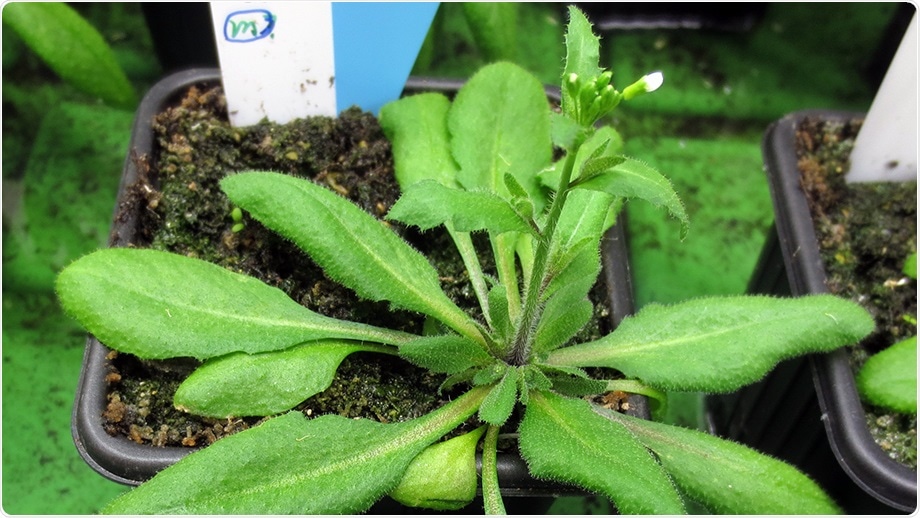Self-fertilizing plants can benefit from the production of fewer sperm cells. Now, an international study, headed by the University of Zurich, has discovered a gene in the plant model Arabidopsis that reduces the number of pollen grains.

The plant species Arabidopsis thaliana is used as a model organism in research all over the world. Image Credit: Misako Yamazaki.
Apart from supporting the evolutionary concept, these outcomes could help improve plant breeding as well as domestication in agriculture.
In the 19th century, Charles Darwin had already identified that the number of male gametes—that is, sperm for animals and pollen for animals—is extremely variable among species and individuals.
At first glance, a high number of male gametes appear to be advantageous for competition among males to produce more numbers of offspring. But several domesticated species are known to have a lower number of male gametes.
Theoretically, it may be beneficial to minimize the cost of producing male gametes, for instance, when the rate of inbreeding or self-fertilization is high, fewer male gametes will be required for successful reproduction.
Genome analysis of self-fertilizing plant
So far there has been little evidence to support this idea, because the production of male gametes is a complex trait affected by many genes with small effects and its molecular basis remained unknown.”
Kentaro Shimizu, Professor, Department of Evolutionary Biology and Environmental Studies, University of Zurich
Headed by Professor Shimizu, an international study currently offers such evidence and reveals that a reduction in the number of pollen grains is not essentially harmful but rather beneficial in a self-fertilizing species.
The scientists employed the well-defined plant model Arabidopsis thaliana for their investigation. This predominantly self-fertilizing plant has a decreased number of pollen grains when compared to its relatives in the wild.
The scientists counted the pollen number of around 144 plants that have a distinct genetic background and identified variations ranging from 2000 to 8000 pollen grains for each flower. The team then made a comparison of the entire genetic data of these variants, searching for the variations between plants with lower and higher pollen numbers.
RDP1 gene controls pollen production
This computational analysis, what is known to be the genome-wide association study, exposed a single gene that impacts the number of pollen produced by every plant. This gene was later dubbed REDUCED POLLEN NUMBER1 (RDP1) gene.
With the help of new genome editing technology called CRISPR-Cas9, the scientists developed several mutant variants of the RDP1 gene, both in plants with lower and higher numbers of pollen grains. The scientists crossed the mutated plants with one another and then counted the pollen produced by the hybrid offspring.
These experiments confirmed the subtle but significant effect of the RDP1 gene.”
Misako Yamazaki, Study Co-Author and Technical Staff, University of Zurich
Yamazaki is a part of Shimizu’s group.
A comparison with other organisms disclosed that the gene encodes a factor that supports the building of ribosomes, which are cellular factories involved in protein synthesis.
Less pollen confers higher fitness
Subsequently, the researchers investigated whether the reduction in the number of pollen grains is positively selected for and did not occur incidentally. For this purpose, they employed a statistical approach to gain a better understanding of the emergence of the RDP1 gene inside the model plants that have different production of pollen grains. The findings proved that the trait for the reduced number of pollen grains has certainly been under positive selection.
In addition, the researchers analyzed the evolution of the various genomic regions linked to the number of pollen grains. The selection on the number of pollens was quite strong when compared to earlier studies of over 100 traits, like environmental responses and disease-resistance. This supports the significance of the number of pollen grains for successful reproduction.
Optimizing fertilization in agriculture
The evidence supports the theoretical prediction that reduced investment in male gametes is advantageous. This is not only important for evolutionary biology but also for the practice of plant breeding and domestication in general.”
Kentaro Shimizu, Professor, Department of Evolutionary Biology and Environmental Studies, University of Zurich
“Many crop plants have a reduced number of pollen due to domestication. Lowering the cost of producing pollen may increase crop yield. On the other hand, too few pollen grains might be an obstacle to breeding and seed production. Our study opens the way for molecular breeding of the optimal pollen number,” Shimizu concluded.
Source:
Journal reference:
Tsuchimatsu, T., et al. (2020) Adaptive reduction of male gamete number in the selfing plant Arabidopsis thaliana. Nature Communications. doi.org/10.1038/s41467-020-16679-7.